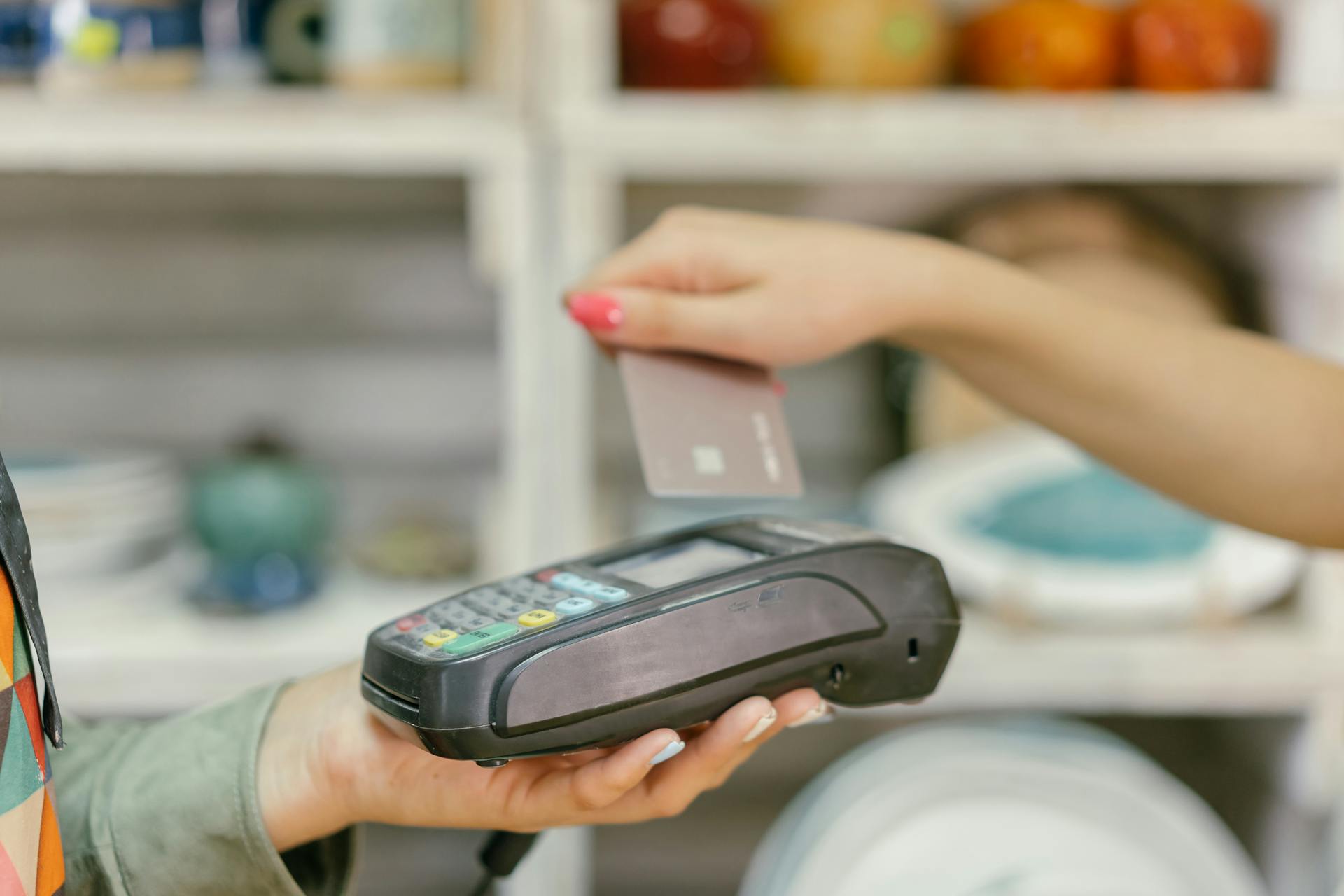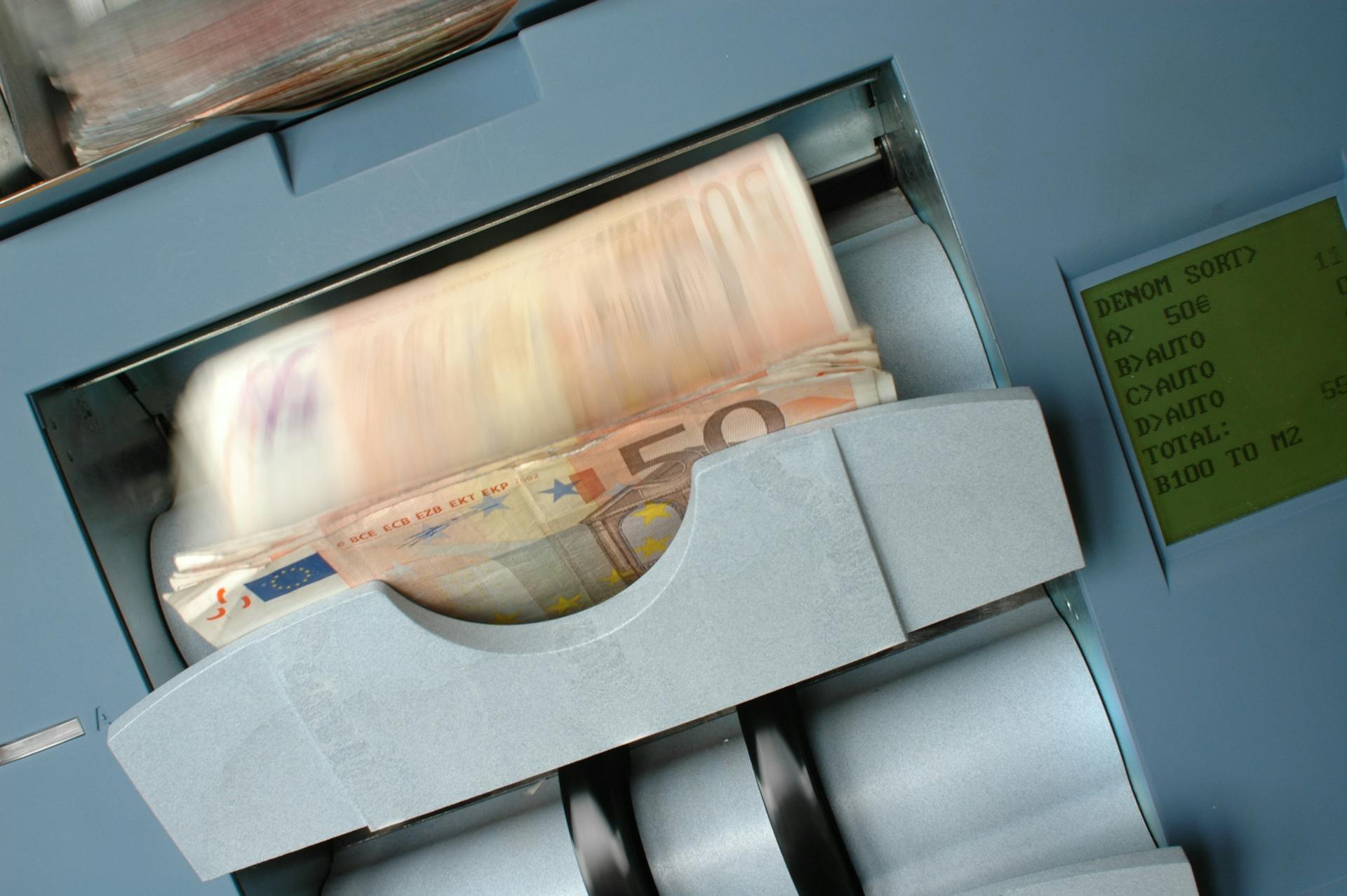
Using e-checks for your business can be a game-changer, especially when it comes to cost savings. According to the article, e-checks can reduce transaction fees by up to 75% compared to traditional check payments.
This means more money in your pocket and a healthier bottom line. With e-checks, you can also enjoy faster processing times, with payments typically taking 1-2 business days to clear.
One of the biggest advantages of e-checks is their convenience. They can be easily integrated into your existing accounting software, making it simple to manage your finances and stay organized.
By switching to e-checks, you can also reduce your risk of check fraud and returned checks, which can be a major headache for businesses.
You might enjoy: Difference between Personal and Business Checks
What Is an E-Check?
An eCheck is a digital payment method that contains the same information as a paper check.
In the United States, eChecks run off the Automated Clearing House (ACH) network, which is managed by the National Automated Clearing House Association (NACHA), a non-profit electronic network that operates under the Federal Reserve.
An eCheck is a "pull" payment, initiated by the payee, who pulls funds from the payer's account, unlike a direct deposit which is a "push" payment initiated by the payer.
The eCheck payment process is facilitated by the ACH network, which operates under the Federal Reserve in the United States.
Benefits of E-Checks
E-checks offer a range of benefits for businesses and individuals alike. They're fast, secure, and easy to use, with processing times often clearing within a single business day.
E-checks are significantly cheaper to process than paper checks and credit cards, with median costs ranging from $0.26 to $0.50 per transaction. In contrast, paper checks can cost between $4 and $20 to issue, and credit card processing fees can be as high as 3.5% of every transaction.
Here are some key benefits of e-checks:
- Cost-effectiveness: e-checks have lower transaction costs compared to credit card payments, especially with high transaction volumes.
- Security measures: e-checks use the ACH network for transactions, which includes numerous security protocols such as encryption and authentication.
- Faster processing time: e-checks often clear within a single business day, improving the rate at which businesses can access funds.
- Improved cash management: with faster processing times, businesses can more accurately forecast their available funds, improving decision-making about investments, payroll, and other expenses.
By switching from paper checks to e-checks, businesses can also reduce their environmental impact, as e-checks are a paperless method of payment. This can help businesses appeal to environmentally-minded customers and make progress towards their own sustainability goals.
Benefits of Checks
E-checks have revolutionized the way businesses process transactions, and for good reason. They're faster, cheaper, and more secure than traditional paper checks.
eChecks are processed significantly faster than paper checks, often clearing within a single business day. This speedier clearance time improves the rate at which businesses can access funds, which is especially beneficial to companies with tight operating margins.
The cost of processing eChecks is also significantly lower than paper checks and credit cards. According to the 2022 Association for Financial Professionals (AFP) Digital Payments Survey, the median cost of initiating and receiving an ACH payment for businesses is between $0.26 and $0.50, compared to $2.00 and $4.00 for paper checks.
In contrast, credit card processing fees can be between 1.3% and 3.5% of every transaction, with the average being 2%. On high-cost items, this quickly becomes very expensive for suppliers.
eChecks also come with multiple layers of authentication to ensure funds are routed properly, reducing the risk of theft and fraud.
Explore further: 2 Coming
The benefits of e-checks extend beyond cost savings and speed. They also provide improved cash management, allowing businesses to more accurately forecast their available funds. This improves decision-making about investments, payroll, and other expenses that require short-term liquidity.
Here are some of the key benefits of e-checks, summarized in a table:
Better for the Environment
E-checks are a game-changer for the environment. They reduce deforestation and cut greenhouse gas emissions from manufacturing and transportation.
By switching to e-checks, you can free up physical space that would otherwise be required to store large quantities of paper records. This is especially useful for businesses that value organization and efficiency.
E-checks also prevent waste from ending up in landfills and oceans. This is a major win for the planet, and it's something that eco-conscious customers are paying close attention to.
In fact, offering e-checks as a payment option can boost your business's reputation for sustainability. This is because e-checks require less energy for physical transportation than paper checks do.
How E-Checks Work
e-checks are a convenient and secure way to make payments, and understanding how they work is essential. They're a digital version of traditional paper checks, but with a much faster processing time.
To initiate an e-check payment, the payer must give explicit permission for the funds to be withdrawn from their bank account. This can be done via a secure online form, a phone call, or a signed document.
The payee collects the necessary banking information from the payer, which usually includes the bank's routing number and the payer's account number. This information is then submitted via a specialized payment gateway or other software.
The Automated Clearing House (ACH) network facilitates the movement of money and information between the banks involved. The payee's bank submits the payment details to the ACH network, which then coordinates with the payer's bank for verification and transfer.
Here's a step-by-step overview of the e-check payment process:
- Authorization: The payer gives permission for the funds to be withdrawn from their bank account.
- Collection of bank details: The payee collects the necessary banking information from the payer.
- Submission for processing: The payee submits the payment details via a payment gateway or software.
- Initiation of the ACH transaction: The ACH network facilitates the movement of money and information between the banks.
- Verification: The payer's bank verifies the account information and availability of sufficient funds.
- Funds transfer: The ACH initiates the transfer of funds from the payer's bank account to the payee's bank account.
- Confirmation and record keeping: Both parties receive confirmation receipts, which are easier to manage and store compared to paper records.
- Settlement: The ACH settles all transactions with the banks, completing the entire process.
The entire e-check payment process usually takes three to five business days, but it's much faster than traditional paper checks.
Check Safety
eChecks are among the most secure payment methods available for businesses, thanks to their processing through the Automated Clearing House ACH network, which is regulated by the Federal Reserve and subject to strict security standards.
Unlike paper checks, eChecks can't be lost or misplace, and bad actors can't take them out of the mail or off of someone's desk. This makes them a safer option for businesses and individuals alike.
The ACH network's strict security standards ensure that eChecks are generally considered safer than traditional paper checks, which can be stolen, lost, or altered in transit. This provides a clear digital record of the payment, which can be helpful for tracking and reconciliation purposes.
Electronic checks also come with a lower risk of associated funds being stolen, as there is no tangible item to intercept. This is a significant advantage over traditional paper checks, which can be a target for thieves.
The average fee per eCheck transaction ranges from $0.30 to $1.50, which is notably lower than the costs associated with issuing a paper check, which can range from $4 to $20. This makes eChecks a cost-effective option for businesses.
In addition to being secure and cost-effective, eChecks also provide a clear digital record of the payment, which can be helpful for tracking and reconciliation purposes. This can help businesses reduce waste and make payment easier for their clients.
By choosing eChecks as a payment option, businesses can offer a safe and convenient way for clients to make financial transactions. This can help attract customers and showcase a company's commitment to reducing waste and making payment easier.
Accept Payments for Your Business
Accepting eCheck payments can be a game-changer for your business.
eChecks are faster and less expensive than paper checks and credit cards, enabling more efficient record-keeping. They can also improve cash flow by eliminating issues associated with expired and reissued credit cards.
To accept eCheck payments, you'll need to sign up for an eCheck or ACH merchant account, which requires providing information like your Federal Tax Identification Number, years in business, and estimated processing volumes.
You can obtain an eCheck merchant account in a matter of days after providing the necessary information. This process is similar to getting a credit card merchant account.
eChecks are convenient for both businesses and customers, eliminating the need to visit the bank to deposit checks. Many financial software systems can automatically record these transactions, reducing administrative workload.
You can automate the preparation, processing, and reconciliation of eCheck payments with the right accounting software. This can save your team a significant amount of manual labor involved with processing payments.
To process an eCheck payment, you'll need to follow three steps: request authorization, payment set-up, and finalize and submit. This process is similar to processing a paper check, but faster and more efficient.
eChecks are regulated by US law, offering a structured dispute resolution process and providing protections against fraudulent activities. This regulatory compliance is essential for businesses to follow and maintain trust with customers.
Curious to learn more? Check out: Legal E Billing Software
The costs associated with issuing an eCheck are notably lower than those associated with paper checks, ranging from $0.30 to $1.50 per transaction. This can save your business a significant amount of money in the long run.
Here's a comparison of the costs associated with paper checks and eChecks:
By accepting eCheck payments, you can provide your customers with a convenient and safe payment option, while also improving your business's cash flow and reducing administrative workload.
E-Check Process and Timing
E-checks are a convenient way to make and receive payments, but have you ever wondered how long it takes for an e-check to clear? Generally, funds are verified within 24 to 48 hours of the transaction being initiated.
The e-check clearing process varies slightly between providers, but typically takes three to five business days. This is significantly faster than paper checks, which can take up to seven days to process.
One of the main advantages of e-checks is that they don't require the same upfront effort as paper checks. You don't need to wait for an e-check to arrive in the mail before processing the payment, which cuts down the overall e-check payment time to just two to five business days.
You might enjoy: Insurance Claim Check Process
e-check transactions are a type of ACH payment, which means they transfer funds between bank accounts using the Automated Clearing House network. This process typically takes 1-3 days, but can take an additional 1-2 business days if the customer's bank account information isn't saved.
Because e-checks are reliant on financial institutions for payment processing, they can't be processed on weekends. If your customer issues an e-check payment on a Monday, it will likely be authorized by Wednesday or Thursday, but the funds won't reach your bank account until early the following week.
In general, e-checks will process or "clear" in five business days at the most, often sooner. For example, if you make a payment on Monday, your payment could clear as early as Thursday.
Check this out: What Bank Does Not Check Chexsystems
E-Check Challenges and Solutions
eChecks aren't perfect, but understanding their downsides and knowing how to address them can help you avoid problems.
Fraud risks are a challenge associated with eChecks, but they can be mitigated with vigilant transaction monitoring and additional security layers.
Insufficient funds in the payer's account can also occur, just like with traditional checks.
Operational adjustments may be necessary, such as updating software systems or training staff, which requires time and resources.
Here are some common challenges associated with accepting eChecks:
- Fraud risks
- Insufficient funds
- Operational adjustments
- Transaction reversals
- Limited international use
- Initial setup fees and ongoing costs
- Customer reluctance
- Regulatory complexity
- Delayed transaction confirmation
- System compatibility
eChecks can reduce chargebacks due to the ACH network's stricter requirements and processes.
Tool Refinement
To refine your eCheck processing, consider scheduling it based on statistical data, such as high-traffic hours and the typical duration between a check's issuance and its clearance. This can minimize system resource strain and reduce costs.
Optimizing your eCheck processing can give you a better sense of when the transaction will be complete. By doing so, you'll avoid unexpected delays and associated revenue losses.
Select a payment gateway that can adapt to future changes in the payments ecosystem. Given the rapid rate of technological evolution, a rigid system could result in future inefficiencies and missed opportunities.
Overcoming Common Challenges
E-checks may have their drawbacks, but understanding these challenges can help you prepare and find solutions. One common challenge is process modification, which can be a significant adjustment for businesses that haven't previously accepted e-checks.
You may need to update your financial software or invest in new software that can handle e-checks, which can be a costly and time-consuming process. This is especially true if you're not familiar with e-checks and need to train your staff on the new systems.
Fraud risks are another challenge associated with e-checks, even though they're generally considered secure. Techniques like account hijacking or using stolen account information can still occur, so it's essential to implement preventative strategies like vigilant transaction monitoring and additional security layers.
Insufficient funds in the payer's account can also be a problem, just like with traditional checks. This is why it's crucial to have a system in place to handle returned transactions and follow up with customers.
Transaction reversals can happen up to 60 days after the transaction, creating uncertainty for businesses. This is why it's essential to have a clear process in place for handling reversals and communicating with customers.
Here are some common challenges associated with accepting e-checks:
- Fraud risks
- Insufficient funds
- Operational adjustments
- Transaction reversals
- Limited international use
- Initial setup fees and ongoing costs
- Customer reluctance
- Regulatory complexity
- Delayed transaction confirmation
- System compatibility
By understanding these challenges and taking steps to address them, you can minimize the risks and make e-checks a valuable payment option for your business.
E-Check Acceptance and Payment Options
To accept e-check payments, you'll need to have an ACH merchant account, which allows businesses to use the ACH network to accept payments via electronic funds transfer.
Businesses must collect the client's financial information, including bank account routing number and payer's checking account numbers, which can be done through a secure form web page on your website, over the phone, or in person with a paper form.
The entire e-check payment processing procedure usually takes three to five business days, with the payment typically clearing within one to two business days.
Curious to learn more? Check out: Small Business Errors and Omissions Insurance
Here are the common steps to accept e-checks using Stripe:
- Account setup: Visit Stripe's website and follow the account registration process.
- ACH Direct Debit activation: Activate ACH Direct Debit transactions for accepting e-checks in your Stripe Dashboard.
- Choosing a Stripe product: Decide which Stripe products to integrate based on your payment flow.
- Implementation: Follow instructions on integrating payment forms, checkout pages, recurring billing, and direct payments.
- Testing: Use test bank accounts to validate that your payment system works correctly.
- Compliance: Ensure you comply with all regulatory requirements concerning ACH Debit transactions.
- Going live: Switch from "view test data" to "view live data" in your Stripe Dashboard to start accepting real e-check payments.
Accepting Stripe Payments
To accept eChecks using Stripe, you'll need to set up an account on their website and follow their account registration process, which includes email verification and business information submission. This will give you access to your Stripe Dashboard.
Stripe supports ACH Direct Debit transactions for accepting eChecks, and to enable this, go to your Stripe Dashboard, locate the “Settings” section, and search for ACH. Activate it, and your account will become capable of handling eCheck payments.
Stripe offers various payment solutions that enable eCheck acceptance, including Stripe Checkout, Elements, Invoicing, Payment Links, and Subscriptions. Each of these solutions has its own unique features and benefits.
To integrate Stripe Checkout, specify “ACH Debit” as an accepted payment method when setting up your Checkout Session. This will give your customers a straightforward way to enter their bank information.
Elements provides UI building blocks that create a compliant payment form for your business, and with Elements, you can easily add an “ACH Debit” form to your checkout process. This handles the more sensitive aspects of data collection and security compliance, freeing you from this complexity.
Here's an interesting read: Extraneous Solutions
To use Stripe Invoicing, send digital invoices that customers can pay via various methods, including eChecks. When setting up an invoice, choose ACH Debit as one of the payment methods.
Here are the Stripe products that enable eCheck payments:
Before going live, make sure to test your payment system using Stripe's test bank accounts to simulate ACH Debit transactions. This will help you validate that your payment system works correctly.
Accepting Them as Payment
Accepting eChecks as payment is a convenient and efficient way for businesses to receive payments from customers. It's similar to traditional paper checks, but with the added benefit of electronic processing.
To accept eChecks, you'll need to sign up for an ACH merchant account, which allows you to withdraw customer funds online via an ACH payment. This requires providing your Federal Tax ID Number, business name and address, years in operation, transaction processing volumes, and bank account number information.
A business can collect financial information from clients, including bank account routing numbers and payer's checking account numbers, through a secure form on their website or over the phone. This information is then used to process eCheck payments.
Businesses can use various payment processors to accept eChecks, including PaySimple, Versapay, and Stripe. These platforms provide a range of payment solutions, such as Stripe Checkout, Elements, Invoicing, Payment Links, and Subscriptions.
To get started with accepting eChecks using Stripe, you'll need to set up an account, activate ACH Direct Debit, and choose a Stripe product that suits your payment flow. This may involve integrating payment forms, checkout pages, recurring billing, or direct payments.
Here's a summary of the steps to accept eChecks using Stripe:
- Account setup: Visit Stripe's website and follow the account registration process.
- ACH Direct Debit activation: Activate ACH Direct Debit in your Stripe Dashboard.
- Choosing a Stripe product: Select a Stripe product that suits your payment flow, such as Stripe Checkout, Elements, Invoicing, Payment Links, or Subscriptions.
- Implementation: Integrate the chosen Stripe product into your website or platform.
- Testing: Test your payment system using Stripe's test bank accounts.
- Compliance: Ensure you comply with all regulatory requirements concerning ACH Debit transactions.
- Going live: Switch from test data to live data in your Stripe Dashboard to start accepting real eCheck payments.
Global
As you explore the world of e-check acceptance and payment options, it's essential to consider the global scope of these transactions. Payments can be made online, and this is a common way for individuals and businesses to make transactions.
E-checks can also be used for in-person payments, making it easier for people to make purchases in physical stores. This is often referred to as terminal payments.
Fraud prevention is a top concern for online transactions, which is why many businesses use radar to detect and prevent fraudulent activity. This helps to ensure a secure payment experience for customers.
Acceptance optimizations can also be achieved through authorization, which helps businesses to streamline their payment processes and reduce the risk of declined transactions.
Frequently Asked Questions
How do I deposit an eCheck?
Deposit an eCheck at a bank or credit union, through an ATM, or using Remote Deposit Capture, just like a regular check. Patented technology helps verify the authenticity of each eCheck for added security.
Is it safe to pay with an e-check?
Yes, e-checks are a secure form of payment, processed through the Federal Reserve-regulated ACH network with strict security protocols in place. This ensures a safe and reliable payment experience.
How do I send an electronic check?
To send an electronic check, sign up for an eCheck service through your bank or a payment processor and follow the authorization process. This digital payment method allows for fast and easy transactions using online banking networks.
How do I pay someone with an eCheck?
To pay someone with an eCheck, you'll need to fill out an online payment form with your bank account and routing numbers, then authorize the payment through the ACH network. This process is similar to writing a paper check, but electronic and more convenient.
What is the difference between ACH and eCheck?
ACH and eCheck differ in their scope, with ACH encompassing various types of electronic transactions and eCheck being a specific type of transaction between checking accounts
Sources
- https://www.versapay.com/resources/what-are-echecks-benefits-accepting-echecks-b2b-businesses
- https://paysimple.com/blog/how-do-echecks-work/
- https://www.investopedia.com/terms/e/electroniccheck.asp
- https://stripe.com/resources/more/what-is-an-echeck
- https://staxpayments.com/blog/what-is-an-echeck-payment/
Featured Images: pexels.com


